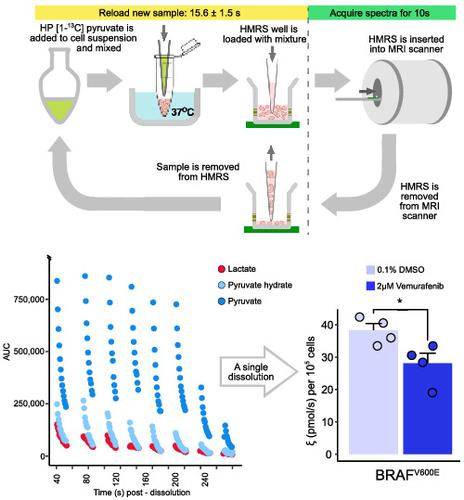当前位置:
X-MOL 学术
›
NMR Biomed.
›
论文详情
Our official English website, www.x-mol.net, welcomes your
feedback! (Note: you will need to create a separate account there.)
Multi‐sample measurement of hyperpolarized pyruvate‐to‐lactate flux in melanoma cells
NMR in Biomedicine ( IF 2.7 ) Pub Date : 2020-12-12 , DOI: 10.1002/nbm.4447 Hannah Lees 1, 2 , Micaela Millan 3 , Fayyaz Ahamed 4 , Roozbeh Eskandari 1, 2 , Kristin L Granlund 1, 2 , Sangmoo Jeong 1, 2 , Kayvan R Keshari 1, 2
NMR in Biomedicine ( IF 2.7 ) Pub Date : 2020-12-12 , DOI: 10.1002/nbm.4447 Hannah Lees 1, 2 , Micaela Millan 3 , Fayyaz Ahamed 4 , Roozbeh Eskandari 1, 2 , Kristin L Granlund 1, 2 , Sangmoo Jeong 1, 2 , Kayvan R Keshari 1, 2
Affiliation

|
Hyperpolarized [1‐13C] pyruvate can be used to examine the metabolic state of cancer cells, highlighting a key metabolic characteristic of cancer: the upregulated metabolic flux to lactate, even in the presence of oxygen (Warburg effect). Thus, the rate constant of 13C exchange of pyruvate to lactate, kPL, can serve as a metabolic biomarker of cancer presence, aggressiveness and therapy response. Established in vitro hyperpolarized experiments dissolve the probe for each cell sample independently, an inefficient process that consumes excessive time and resources. Expanding on our previous development of a microcoil with greatly increased detection sensitivity (103‐fold) compared with traditional in vitro methods, we present a novel microcoil equipped with a 10‐μL vertical reservoir and an experimental protocol utilizing deuterated dissolution buffer to measure metabolic flux in multiple mass‐limited cell suspension samples using a single dissolution. This method increases efficiency and potentially reduces the methodological variability associated with hyperpolarized experiments. This technique was used to measure pyruvate‐to‐lactate flux in melanoma cells to assess BRAF‐inhibition treatment response. There was a significant reduction of kPL in BRAFV600E cells following 24 and 48 hours of treatment with 2 μM vemurafenib (P ≤ .05). This agrees with significant changes observed in the pool sizes of extracellular lactate (P ≤ .05) and glucose (P ≤ .001) following 6 and 48 hours of treatment, respectively, and a significant reduction in cell proliferation following 72 hours of treatment (P ≤ .01). BRAF inhibition had no significant effect on the metabolic flux of BRAFWT cells. These data demonstrate a 6‐8–fold increase in efficiency for the measurement of kPL in cell suspension samples compared with traditional hyperpolarized in vitro methods.
中文翻译:

黑色素瘤细胞中超极化丙酮酸到乳酸通量的多样本测量
超极化的[1- 13 C]丙酮酸盐可用于检查癌细胞的代谢状态,突出癌症的一个关键代谢特征:即使在有氧存在的情况下,乳酸的代谢通量也会上调(瓦尔堡效应)。因此,丙酮酸到乳酸的13 C 交换速率常数k PL可以作为癌症存在、侵袭性和治疗反应的代谢生物标志物。已建立的体外超极化实验独立溶解每个细胞样本的探针,这是一个低效的过程,消耗过多的时间和资源。与传统体外方法相比,我们对之前开发的微线圈进行了扩展,检测灵敏度大大提高(10 3倍),我们提出了一种配备 10 µL 垂直储液器的新型微线圈和利用氘化溶解缓冲液测量代谢的实验方案使用单次溶解的多个质量限制细胞悬浮液样品中的通量。该方法提高了效率,并可能减少与超极化实验相关的方法变异性。该技术用于测量黑色素瘤细胞中丙酮酸到乳酸的通量,以评估 BRAF 抑制治疗的反应。用 2 μM 维莫非尼治疗 24 小时和 48 小时后,BRAF V600E细胞的k PL显着降低( P ≤ .05)。这与分别在治疗 6 小时和 48 小时后观察到的细胞外乳酸 ( P ≤ .05) 和葡萄糖 ( P ≤ .001)库大小的显着变化以及治疗 72 小时后细胞增殖的显着减少相一致(P ≤ .01)。BRAF抑制对BRAF WT细胞的代谢通量没有显着影响。这些数据表明,与传统的超极化体外方法相比,细胞悬浮液样品中k PL的测量效率提高了 6-8 倍。
更新日期:2021-02-04
中文翻译:

黑色素瘤细胞中超极化丙酮酸到乳酸通量的多样本测量
超极化的[1- 13 C]丙酮酸盐可用于检查癌细胞的代谢状态,突出癌症的一个关键代谢特征:即使在有氧存在的情况下,乳酸的代谢通量也会上调(瓦尔堡效应)。因此,丙酮酸到乳酸的13 C 交换速率常数k PL可以作为癌症存在、侵袭性和治疗反应的代谢生物标志物。已建立的体外超极化实验独立溶解每个细胞样本的探针,这是一个低效的过程,消耗过多的时间和资源。与传统体外方法相比,我们对之前开发的微线圈进行了扩展,检测灵敏度大大提高(10 3倍),我们提出了一种配备 10 µL 垂直储液器的新型微线圈和利用氘化溶解缓冲液测量代谢的实验方案使用单次溶解的多个质量限制细胞悬浮液样品中的通量。该方法提高了效率,并可能减少与超极化实验相关的方法变异性。该技术用于测量黑色素瘤细胞中丙酮酸到乳酸的通量,以评估 BRAF 抑制治疗的反应。用 2 μM 维莫非尼治疗 24 小时和 48 小时后,BRAF V600E细胞的k PL显着降低( P ≤ .05)。这与分别在治疗 6 小时和 48 小时后观察到的细胞外乳酸 ( P ≤ .05) 和葡萄糖 ( P ≤ .001)库大小的显着变化以及治疗 72 小时后细胞增殖的显着减少相一致(P ≤ .01)。BRAF抑制对BRAF WT细胞的代谢通量没有显着影响。这些数据表明,与传统的超极化体外方法相比,细胞悬浮液样品中k PL的测量效率提高了 6-8 倍。











































 京公网安备 11010802027423号
京公网安备 11010802027423号